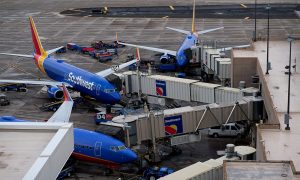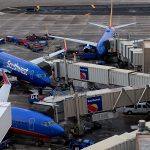Here’s a list of key terms and lingo to help you navigate airline stories:
Available Seat Miles – a measure of capacity on a plane or train. Calculated by multiplying the number of seats by miles traveled.
Bank – group of flights scheduled to leave a hub (see below) airport at about the same times for connecting purposes (see below).
Bump – the practice of denying a seat to a passenger with a confirmed reservation when a flight is oversold (see below). Bumped passengers must be compensated under U.S. law.
Cabotage – a right granted by some governments to foreign airlines to operate domestic flights within their country. Cabotage is forbidden in the United States.
Code share – a marketing agreement under which two or more airlines share a two-letter designator code used in computerized reservations systems, so it appears that itinerary is on one airline. Most often used by major airlines and commuter/regional partners (see below).
Commuter – a small airline that usually operates under contract to a large airline to carry passengers from small towns to their hub. These carriers, also known as regionals, usually operate under a derivative of a major carrier’s name, such as American Eagle or Delta Connection, and may be either independent companies or subsidiaries of a large airline.
Connection – a flight itinerary that involves changing planes, usually at a hub airport (see below).
Contract of Carriage – the airline equivalent of terms and conditions when downloading a piece of software. You are assumed to have accepted this contract when you buy a ticket. It limits your rights and the airline’s liabilities when certain things go wrong, including when your luggage is lost on international flights.
MORE on COVERING TRANSPORTATION
Intro: Economy, equipment, people
Key resources in transportation
Get out and find local angles
Common errors to avoid
Glossary for covering airlines
Cost per ASM – the key measurement of an airline’s operating expenses. The bookend component of yield (see below).
Direct Flight – one that goes from one city to another without involving a change of planes. A direct flight is NOT necessarily nonstop.
Fixed-Base Operator (FBO) – a company that operates a general-aviation (see below) airport or general-aviation portion of a commercial airport, under contract to an airport authority or municipality.
General Aviation – private or corporate aircraft, as opposed to commercial flight operations.
Hub-and-spoke – A route system in which an airline funnels most of its flights through several large airports where passengers have to change planes. Most domestic U.S. airlines use a hub and spoke system, with Southwest Airlines being a notable exception.
Load Factor – the percentage of available seats occupied by paying passengers. A key measure of operating performance for airlines and Amtrak.
Mainline – the “major-airline” part of a route network that also involves regional airline partners. Mainline employees are covered by their own union contracts and are usually paid significantly more than employees at partner carriers.
Narrow-body – An airplane with one aisle between the seats.
On-Time performance – a key measure of service if somewhat of a misnomer. The definition of “on-time” for regulatory purposes is a flight or train that arrives or departs within 15 minutes of its published schedule.
O&D – origin & destination traffic, as opposed to airline traffic and passengers that travel through a hub airport and connect to someplace else.
Overbooking – the practice by airlines of selling more seats than exist on a flight, to protect themselves from no-shows.
Ramp – the area next to terminal building where baggage is loaded and unloaded.
Passenger Facility Charge (PFC) – A fee of up to $4.50 per flight segment added onto airline tickets, to pay for airport improvements.
RJ – short for regional jets, planes that typically have 70 or fewer seats and used to fly between cities where there is not enough passenger demand traffic to fill a larger plane like a 737.
Turboprop – planes driven by piston engines with propellers rather than jet engines. These are being phased out by regional jets.
Wide-Body – An airplane with more than one aisle running between seats.
Yield – the amount of revenue, in cents, per passenger per mile flown. This is the key measure of revenue for transportation providers.
Yield Management – complex computer program intended to price each seat to get the most amount of money possible.










